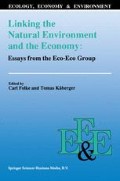Abstract
Arable land can be treated as a production resource, with a natural resource component and an anthropogenic capital component. It is a stock, giving a renewable flow. The arable land resource has a quantitative dimension (hectares) and a qualitative one, which may be described by innumerable edaphic, topographic and climatic site parameters. Instead of measuring the resource stock (hectares, site parameter data), the resource is measured by its capacity to generate a flow. Physical measurements are derived by combining existing statistics with production functions. They are expressed in kilo barley-equivalents per hectare, and calculated for each of the 420 “homogenous” agricultural districts in Sweden. A concept called standard-hectares is developed, making acreage comparisons possible amongst different grades of land. The economic measure of the resources is land rent As the residual of revenues minus costs in crop production it should reflect the different use-capacities of various plots of land. Swedish arable resources measured by land rents are fairly heterogeneous, showing distinct regional patterns. In 1983 the rent on Swedish tilled land was nearly normally distributed around a mean of US$ 100 per hectare. From 1968 to 1983 land rents declined, especially in the far south and in the north. The arable land resource situation is further illustrated by a new diagram that plots land rent against cumulative acreage. The barley-equivalents and land rents methods each provide a single, cardinal measure appropriate for comparing land of different quality. Further, a computerized model of Swedish arable resources was used to study the impacts of resource influencing factors. Possible resource situations are simulated on the basis of assumptions about the effects of factors like subsoil compaction, erosion, photochemical oxidants, on yields or costs. Air pollutants like ozone, subsoil compaction and urban expansion appear to be the most menacing factors. The possible effects are of such magnitude as to constitute a risk to the security of our food supply. Many of these factors are likely to exert their greatest negative influence on the plains in south and central Sweden, thus causing changes in the regional distribution of arable land resources, and also tending to make them less heterogeneous in the future.
Access this chapter
Tax calculation will be finalised at checkout
Purchases are for personal use only
Preview
Unable to display preview. Download preview PDF.
References
Adams, R.M., Glyer, J.D., Johnson, S.L. and McCarl, B.A. (1989). A reassessment of the economic effects of ozone on U.S. agriculture. JAPCA 39:960–968.
Anonymous, 1953. Atlas over Sverige 63-64. Åkermarkens matjordstyper. Svenska sällskapet för antropologi och geografi. Stockholm.
Anonymous. 1974. Statistiska meddelanden J 1974:20. Statistics Sweden, Stockholm, Sweden.
Anonymous. 1976. Den Danske Jordldassifisering. Teknisk redegörelse. Landbrugsministeriet, Copenhagen.
Anonymous. 1979. Statistiska meddelanden J 1979:8.6. Statistics Sweden, Stockholm, Sweden.
Anonymous. 1983a. Statistiska meddelanden J 1983:7.2. Statistics Sweden, Stockholm, Sweden.
Anonymous. 1983b. Statistiska meddelanden J 1983:8.1. Statistics Sweden, Stockholm, Sweden.
Anonymous. 1983c. Områdeskalkyler-Jordbruk 1983. Research Information Centre. The Swedish University of Agricultural Sciences, Uppsala.
Anonymous. 1984a. Statistiska meddelanden J 1984:8.1. Statistics Sweden, Stockholm, Sweden.
Anonymous. 1984b. Statistiska meddelanden J 1984:9.1. Statistics Sweden, Stockholm, Sweden.
Barlowe, R. 1978. Land Resource Economics. Prentice-Hall, Englewood Cliffs, New Jersey.
Dent, D. and Young, A. 1981. Soil Survey and Land Evaluation. George Allen & Unwin, London.
Eriksson, J., Håkansson, I. and Danfors, B. 1975. Jordpackning-Problem inom det Högmekaniserade Jordbruket. Konsulentavdelningens stencilserie. Allmänt 1. The Swedish University of Agricultural Sciences, Uppsala.
Food and Agriculture Organization of the United Nations. 1976. A Framework for Land Evaluation. Soils Bulletin 32.
Håkansson, I. 1985a. Personal communication. Department of Soil Sciences, The Swedish University of Agricultural Sciences, Uppsala.
Håkansson, I. 1985b. Swedish Experiments on Subsoil Compaction by Vehicles with High Axle Load. Soil Use and Managern 1985(4).
Hasund, K.P. 1986. Jordbruksmarken i Naturresursekonomiskt Perspektiv. Department of Economics, Report 269. Swedish University of Agricultural Sciences, Uppsala.
Hedvåg, L., Hasund, K.P. and Pleijel, H. 1990. Ekonomiska Konsekvenser av Ozonpåverkan på Jordbruksgrödor. Swedish Environmental Protection Agency, Stockholm. In press.
Mattsson, L. and Bjärsjö, J. 1981. Kvävegödsling till Korn. Department of Soil Sciences, Report 135. The Swedish University of Agricultural Sciences, Uppsala.
Nihlén, T. 1984. Utredning av den för Vinderosion Utsatta Marken i Skåne. Department of Physical Geography, Report 58. University of Lund, Lund.
Ricardo, D. 1817. On the Principles of Political Economy and Taxation. Murray, London.
Salter, L. A. 1967. A Critical Review of Research in Land Economics. The University of Wisconsin Press, Madison, Wisconsin.
Skärby, L. 1982. Effekter av Luftföroreningar på Vegetation. Fotokemiska Oxidanter. Swedish Environmental Protection Agency, PM 1562, Stockholm.
Skärby, L. 1985a. Effekter av Gasformiga Luftföroreningar på Vegetetion med särskild hänsyn till Fotokemiska Oxidanter. Report from the Institute for Water and Air Pollution Research (IVL), Gothenburg.
Skärby, L. 1985b. Personal communication. IVL, Gothenburg.
Author information
Authors and Affiliations
Editor information
Editors and Affiliations
Rights and permissions
Copyright information
© 1991 Springer Science+Business Media Dordrecht
About this chapter
Cite this chapter
Hasund, K.P. (1991). Arable Land as a Resource. In: Folke, C., Kåberger, T. (eds) Linking the Natural Environment and the Economy: Essays from the Eco-Eco Group. Ecology, Economy & Environment, vol 1. Springer, Dordrecht. https://doi.org/10.1007/978-94-017-6406-3_7
Download citation
DOI: https://doi.org/10.1007/978-94-017-6406-3_7
Publisher Name: Springer, Dordrecht
Print ISBN: 978-90-481-4089-3
Online ISBN: 978-94-017-6406-3
eBook Packages: Springer Book Archive

